The Shih Tzu is among the most popular dogs worldwide, including in the United States. There is not much to dislike about these adorable little family companions.
The Shih Tzu is an ancient dog breed. Some of the first records of Shih Tzus come from China, and they are more than 1,000 years old!
However, Shih Tzus originate from Tibet. From there, they were brought to Chinese courts. The Chinese breeders mixed them with either Pugs or Pekingese to create the adorable pups we know today.
These Little Lion Dogs have gotten their name from not just their long, fluffy coats, but also from their fierce temperaments. They have the heart of a lion and will never back down from danger!
Another thing that makes these cutie pies stand out is the huge number of coat colors these doggies come in. In fact, Shih Tzu is one of the most colorful breeds you can find! And almost no coat color can match the Red Shih Tzus.
Red Shih Tzus are not the most usual Shih Tzu color out there. Many dog lovers don’t even realize these pups can come in red coat color.
So, how common are red Shih Tzus, and do they stand out from the rest? If red is your favorite dog color, you’re in the right spot.
Here’s everything you need to know about red Shih Tzus:
Shih Tzu Coat Colors
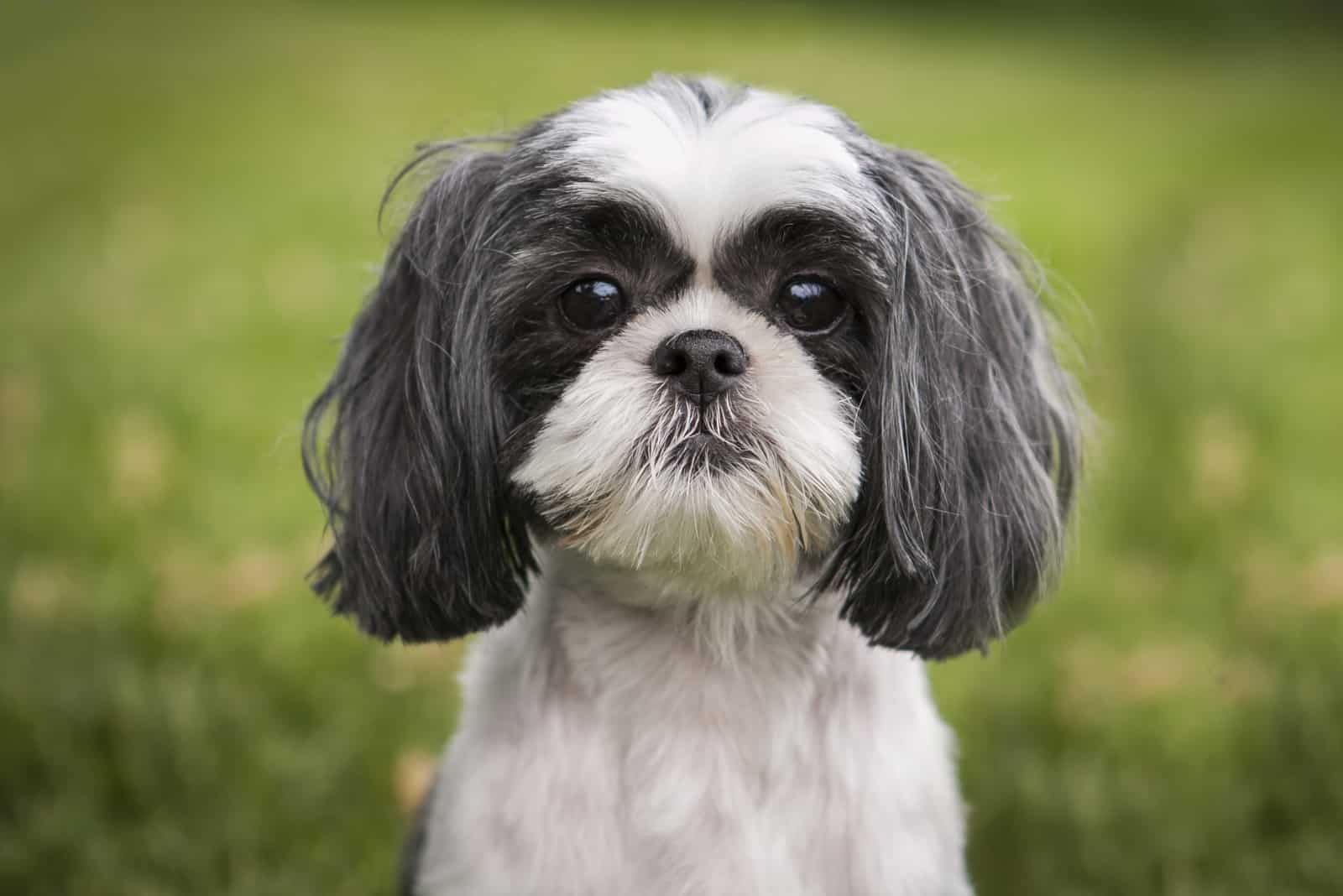
The Shih Tzus can come in many different coat colors. In fact, they are even more colorful than the Poodles, which are considered some of the dogs with the highest number of coat colors out there!
In fact, Shih Tzu coat colors are so unique you can hardly find two dogs that look alike.
However, this wide array of colors can confuse many aspiring dog owners – especially when we look at the fact that Shi Tzus are known to experience color change!
Most people are familiar with common Shih Tzu coat colors, such as silver or black & white. Even some rare markings, such as black tips, brindle, black mask, Dobie markings, and white patches can be found in Shih Tzu dogs.
But not many know that red Shih Tzus exist – and they are absolutely adorable!
Red Shih Tzu

Photo from: @chewie.shihtzu
Red Shih Tzus are one of the most unique coat colors in this breed. They can come in a solid color, with gold or white markings, and some are even considering red merle to be another color combination.
Red Shih Tzus come in a deep, dark orange coat color. While the Shih Tzu puppies can come in pure red, these deep ginger shades are more common in adult dogs.
Solid colored red Shih Tzus shouldn’t have any white markings on their body. However, they should have dark brown eyes, black noses, as well as black lips, paw pads, and eye rims.
Red coat color is caused by pure pheomelanin pigment, one of the two basic pigments found in dogs – the other one being eumelanin, which is responsible for black coat color.
In fact, the red coat color is considered the base color for yellows, gold, tans, and creams. This is why many dogs, such as Labrador Retrievers, come in various colors that many people would simply consider different shades of the same color. It all comes down to pheomelanin distribution.
Various different genes determine the exact distribution of pheomelanin, which will result in different red shades.
This is also the reason why there are more than three colors in dogs – red (pheomelanin), black (eumelanin), and white (lack of pigment).
Red & White Shih Tzu
Red and white Shih Tzus have a red base color with white markings. These markings can be distributed anywhere on their bodies – but the less irregular they are, the more desired the Shih Tzu.
Red and white Shih Tzus are considered more common than solid red Shih Tzus. Many dogs will have at least a small white marking on their bodies – something that would disqualify them from being considered solid-colored.
These pups can come with many patterns, including parti, tuxedo, and sometimes even spotted!
However, they mustn’t have more than 50% of their bodies covered in white markings. If they do, then they would be considered white and red Shih Tzus – a color combination that is considered faulty for its lack of pigmentation.
Red & Gold Shih Tzu
Red and gold Shih Tzus are one of the rarest varieties of red Shih Tzus. These double-colored dogs have a red base coat and cream to dark gold markings.
Many of these pups also have a darker mask which is rarely entirely black in color, but this can happen, as well.
Sometimes, a sable Shih Tzu can be confused with a red and gold Shih Tzu.
Sable dogs have dark hair tips, and this can create an illusion that a dog comes in two different colors, even when this isn’t the case.
Red Merle Shih Tzu
Merle dogs have a rather distinguishable pattern. They are tricolor dogs that have three shades of the same coat color on them.
The most common merle dogs are blue merles. These dogs have a blue base coat with white markings and splotches of black color on them.
Similarly, red merles have a cream base coat color with large portions of white coat and splotches of red coat color.
Merle is caused by a partial dilution gene. This is similar to the gene that is causing blue and liver coat color – but I’ll talk more about them a bit later.
This is a dominant gene that causes irregular dilution of the coat color. When it affects red dogs, it causes the red merle pattern.
These dogs usually have liver noses, but butterfly noses are also common. Also, it isn’t uncommon for these pups to have blue eyes or even different colored eyes (heterochromia).
However, I would like to point out that, despite their name, red merle Shih Tzus are considered liver dogs and not red ones due to the color of their nose.
Not just that, but the merle gene isn’t naturally found in Shih Tzus. This means that all Shih Tzus with a merle pattern are mixed breed dogs, even if this mixing happened many generations ago.
The Merle Gene Controversy
There is a reason why you don’t see many red Shih Tzus with a merle pattern. This is because the merle gene is filled with various controversies.
The problem isn’t in the merle gene itself, but rather in so-called double merles. These are the dogs that have inherited two merle genes – one from each parent.
Double merles don’t look like standard merles. The combined effects of two merle genes cause these dogs to come in a pure white coat (although sometimes spots of the original color can be seen) with strikingly blue eyes or heterochromia.
While these pups might sound beautiful, the merle gene is so strong in them that it causes all sorts of health problems. This includes hearing and vision problems, cardiovascular issues, and fragile bones.
Because of this, many experts and Shih Tzu owners alike are strictly against breeding merle dogs.
Dogs with a single merle gene won’t have an increased chance of getting health problems. This might make it seem like it’s easy to avoid double merles – you simply don’t breed two merle Shih Tzus.
However, the issue comes with cryptic merles. Cryptic merles are dogs that carry the dominant merle gene, but the merle is barely noticeable.
These dogs are often confused with dogs that aren’t merles – for example, red Shih Tzus.
This means that breeding any merle dog carries a risk of creating a double merle.
To keep this from happening, most kennel clubs and reputable breeders frown upon the intentional breeding of merle Shih Tzus.
As such, most merle Shih Tzus are either accidental or the result of irresponsible breeders who don’t care about the wellbeing of their dogs.
Liver Shih Tzu
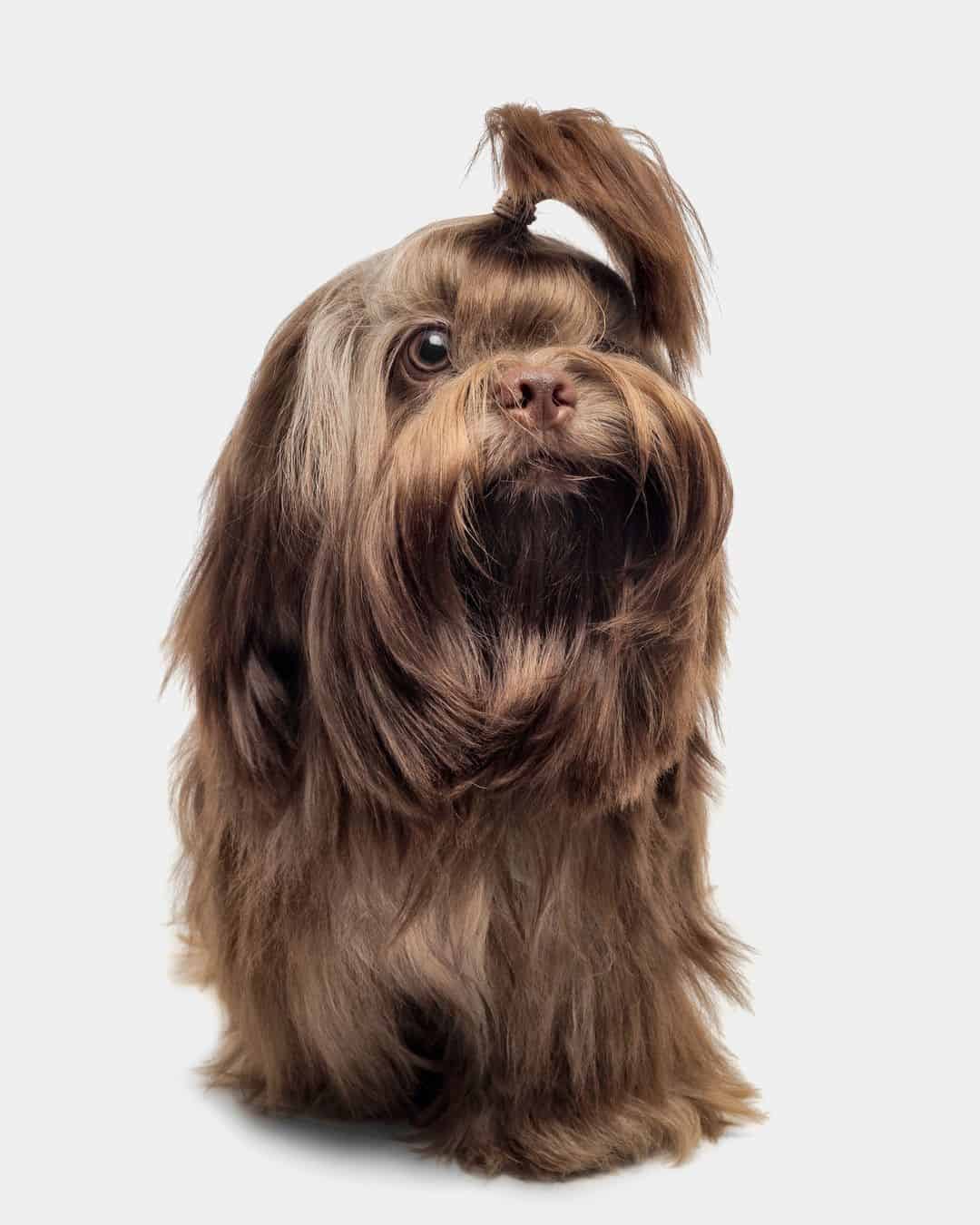
Photo from: @thepetvisuals
Liver Shih Tzus usually have a deep brown or mahogany coat color. They can come in a solid color or in combination with white markings, but they’ll rarely be tricolor.
However, liver Shih Tzus can be determined by more than just the dog’s coat color.
Liver dogs are the product of yet another dilution gene known as liver dilution. This is a recessive gene that affects black pigment, turning into a chocolate color.
This dilution affects any black pigment, not just the one found on the coat color. This includes the dog’s nose, eye rims, paw pads, and lips. In liver dogs, these body parts will always be liver-colored.
Also, it affects the pigment in their eyes, which is why liver dogs usually come with light brown, hazel, or even green eye colors!
In other words, a dog doesn’t have to be liver-colored to be considered liver. This dilution gene won’t affect pheomelanin – only eumelanin.
This means that you can see a Shih Tzu with gold, cream, or even red coat color that is, in fact, a liver Shih Tzu.
Another gene that works the same way is the blue dilution gene. This is yet another dilution gene that affects only eumelanin that can be recognized by the dog’s nose color.
The biggest difference is that the blue dilution dene turns black coat color into a bluish-gray shade, while the liver will give it a deep red to chocolate color.
How To Make A Difference Between Liver And Red Shih Tzus?
At the first glance, liver and red Shih Tzus can be confused with one another. And while they both can have deep red color coats, there are a few significant differences between the two.
The first difference can be seen in the shade of their coat. Red-colored Shih Tzus usually have brighter shades compared to somewhat duller liver Shih Tzus.
Secondly, liver Shih Tzus will always have a brown nose, while red Shih Tzus have black noses.
In fact, this is the main difference you should look at.
Some liver dogs might have a bright red coat. This is because the dilution gene doesn’t affect pheomelanin in the same way as it does eumelanin.
Stil, red Shih Tzu’s nose has to come in black color. If it’s brown, this means that the dog cannot be classified as red Shih Tzu, but only as the liver one.
Finally, these two coat colors are caused by entirely different genetics. Red dogs are the product of pure pheomelanin pigment, while liver Shih Tzus are the result of the liver gene affecting black dogs.
Understanding these differences is very important if you’d like to register your dog within the AKC. You need to know the official name of the coat color your Shih Tzu has.
Are Red Shih Tzu Accepted By Kennel Clubs?
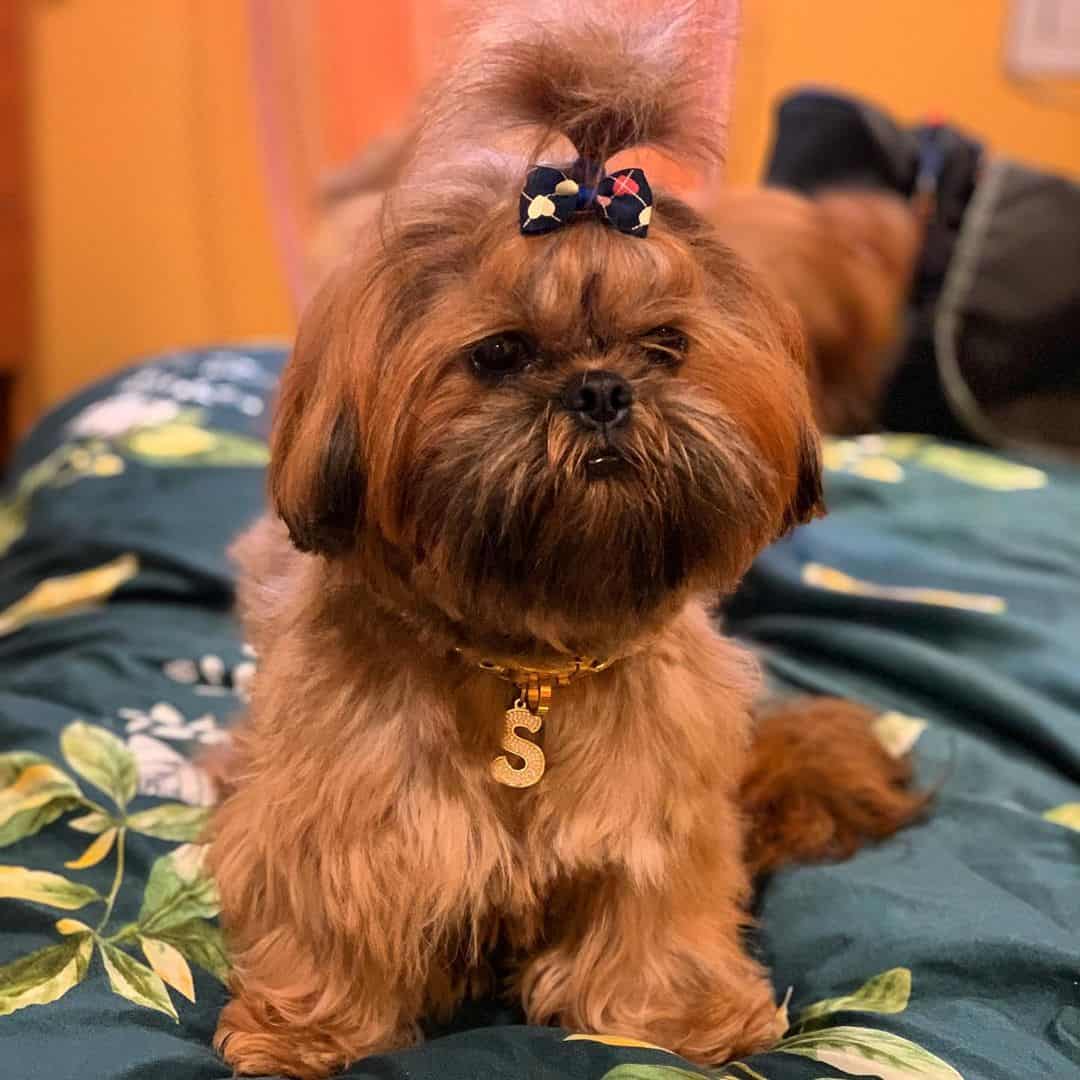
Photo from: @spicy_potato_adventures
Not all coat colors are allowed by kennel clubs. Kennel clubs are canine organizations that help regulate dog breeds in your area.
If you live in the U.S.A., you are probably familiar with the American Kennel Club (AKC). This is the main kennel club for the states, and all purebred dogs have to be registered with it to get the necessary papers.
Luckily for all lovers of this fiery color, red Shih Tzus are allowed not just by the AKC, but by all other major kennel clubs across the world. This is considered the standard Shih Tzu color – for the biggest part.
The two exceptions are the red and gold Shih Tzus and the red merle Shih Tzu.
The red and gold combination is considered highly undesirable, and it isn’t considered a standard color by most standards.
On the other hand, no variety of the merle coat is allowed due to the health problems this color carries.
Another reason why these two color combinations aren’t allowed is that they aren’t found naturally within the Shih Tzu breed. This indicates that the dog that comes in such a color is likely a crossbreed and not a purebred dog.
Kennel clubs make sure that a certain breed is present within the dog’s genetics before they agree that it can be accepted.
This doesn’t mean that all colors that aren’t standard are a clear sign that the dog is purebred. However, chances are very high.
If anything else, dogs that don’t come in standard colors cannot be registered, which means that there is a high probability that the breeder doesn’t use proper breeding practices.
This is why most experts advise dog lovers against buying dogs that come in rare colors.
Standard Shih Tzu Colors
While all coat colors are allowed, you can register your dog under one of the 18 colors that are allowed in the AKC’s registration.
This doesn’t mean that AKC doesn’t allow dogs of other colors. You’ll simply have to find criteria your dog can fit under.
These 18 coat colors are:
• Blue and white Shih Tzus.
• Gold and white Shih Tzus.
• Red Shih Tzus.
• Red and white Shih Tzus.
• Liver and white Shih Tzus.
• Silver and white Shih Tzus.
• Lavender Shih Tzus, also known as Isabella Shih Tzus.
• Brindle and white Shih Tzus.
• Tricolor Shih Tzus.
• Albino Shih Tzus.
As you can see, red Shih Tzus have their place on their list.
Keep in mind that different kennel clubs might have different breed standards.
For example, the United Kennel Club (UKC) doesn’t allow albino Shih Tzus, while the Federation Cynologique Internationale (FCI) allows all coat colors, but considered parti Shih Tzus with a white blaze on their foreheads and a white tip of the tail the most desirable ones.
Are Red Shih Tzus Rare?
Solid red Shih Tzus are fairly rare Shih Tzus, although they are not as rare as some other colors and patterns. However, red and white Shih Tzus are considered rather common.
Red and gold Shih Tzus, on the other hand, are among the rarest Shih Tzu colors you can find, together with red merle dogs.
As this isn’t an unusual coat color, it won’t affect the dog’s price too much. You can find these pooches at the standard Shih Tzu price, which is usually around $1,200.
Shih Tzu Coat Color Change

Shih Tzus are rather unique dogs in more than one way. For example, all Shih Tzus are likely to change color of their coat to a certain extent.
A Shih Tzu is usually born in one color, but the shade can turn out to be entirely different by the time they are one year old.
In red Shih Tzus, for example, puppies tend to have a rich red shade to their coat. However, you’ll rarely see this coat color in adult dogs. This is because their coat color has changed by the time they’ve reached adulthood.
In fact, the only coat color that isn’t likely to change is the black and white color combination. Red and white will experience fewer changes than most other colors, but they’ll still be somewhat apparent.
It’s in Shih Tzu’s genetics to change their coat color. In fact, if a Shih Tzu doesn’t experience any color change, he might be a mixed breed.
This is because Shih Tzus have two different genes that cause two types of color change.
First, you have the G gene. The G gene will cause the Shih Tzu’s coat to fade over time. Its color will lighten or turn gray, making some dogs look much older than they really are.
Fading will usually occur before your pooch is one year old. The coat should reach its final color by this time.
Another gene that causes the Shih Tzu’s coat to change is the Chinchilla Gene (CH series). The Chinchilla gene will cause graying. This is similar to fading, but the dog’s coat won’t look duller over time. Quite the opposite, it will turn into a rich, silvery shade.
As these genes are naturally present within Shih Tzu’s genetics, there is little you can do to prevent the color change.
However, some studies have shown that bad quality of life and environmental factors can worsen the effects of these genes and affect the look of your pup.
To try to reduce the color change to a minimum, you should take good care of Shih Tzu and make sure he lives in a healthy environment.
You shouldn’t stress out your dog too much, as stress is also a trigger that can lead to a significant change in shade.
Top-quality dog food is also important, as a balanced diet is a key to your dog’s coat looking as healthy as possible.
Also, sun exposure can temporarily cause your dog’s coat to fade. If you want your Shih Tzus coat color to stay as shiny and colorful as possible, you should limit his time out in the sun.
If you take good care of your red Shih Tzu coat, you can increase the chances of it staying as vibrant as possible.
However, don’t expect your Shih Tzu to look as colorful as an adult as he did when he was a puppy. This is just something that comes with being a Shih Tzu owner, and it can make your dogs more unique.
Red Shih Tzu Health Concerns
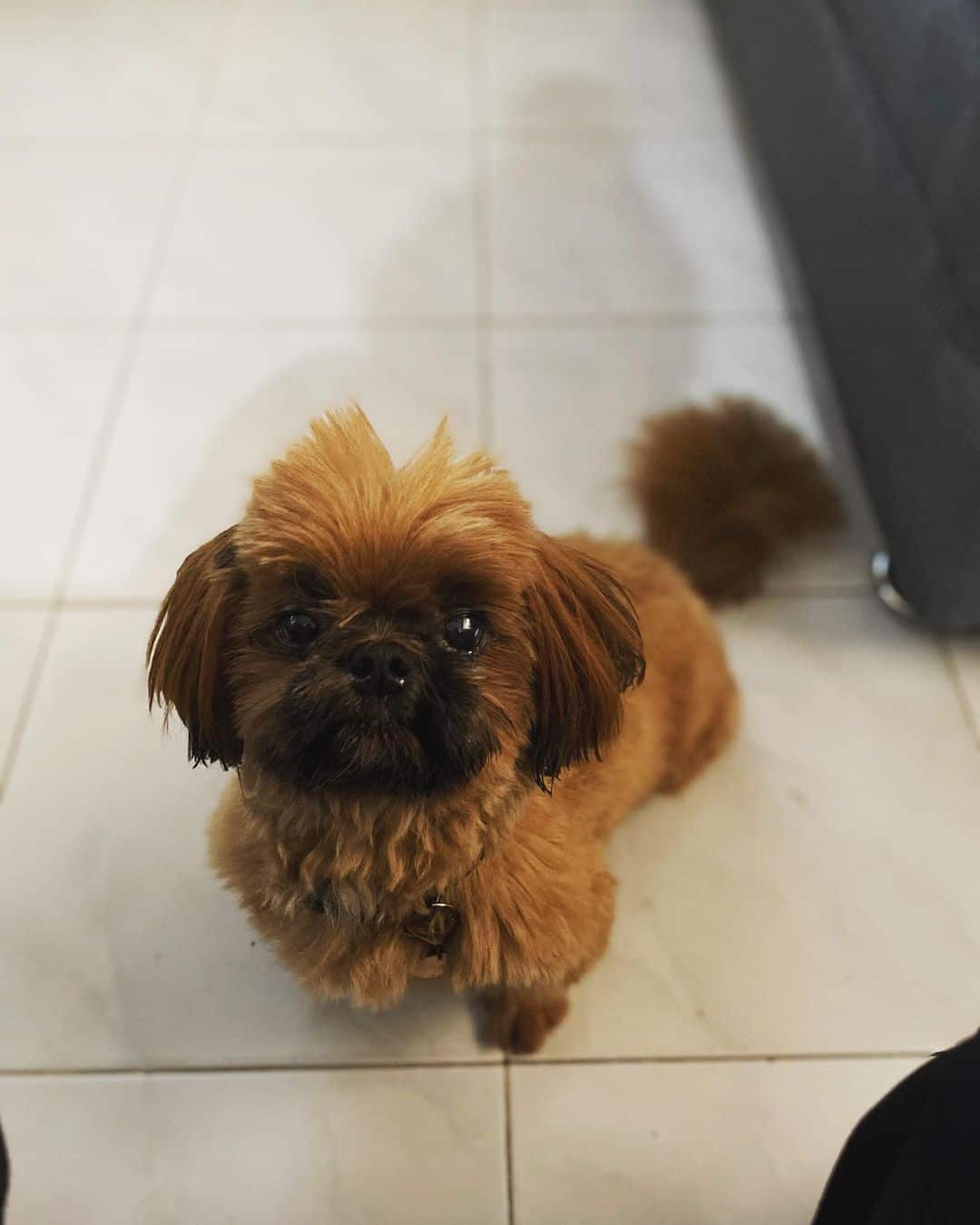
Photo from: @redshihtzu_stewie
It has been proven that some coat colors can affect the dog’s health. Such is the merle gene that we’ve talked about, but it isn’t the only one.
For example, solid white dogs seem to have a higher risk of skin and eye problems due to their lack of pigment. Albino dogs are white due to the condition that has left them devoid of any pigment and with many health problems.
Even dilution genes such as liver seem to increase the chance of health problems, even though this percentage is much lower than in the case of white or merle dogs.
Fortunately, though, red Shih Tzus are as healthy as any other Shih Tzu dog.
There isn’t any indication that the presence of red coat color will affect not just the dog’s health, but temperament, as well. These dogs are just like Shih Tzus of any other color, with a few differences in their appearance.
This still means they are prone to all health conditions Shih Tzus can get. This includes breathing issues, eye problems, hip dysplasia and other joint problems, as well as hypothyroidism.
With a proper diet and regular visits to the vet, you can ensure your Shih Tzu lives a long and healthy life.
These are small dogs that aren’t very active. This makes them rather prone to obesity, which can increase the chance of most other health problems.
If you take proper care of your red Shih Tzu puppy, you can expect him to live to the end of his long lifespan. In fact, Shih Tzus are estimated to live up to 16 years on average, making them some of the longest living canines.
FAQs
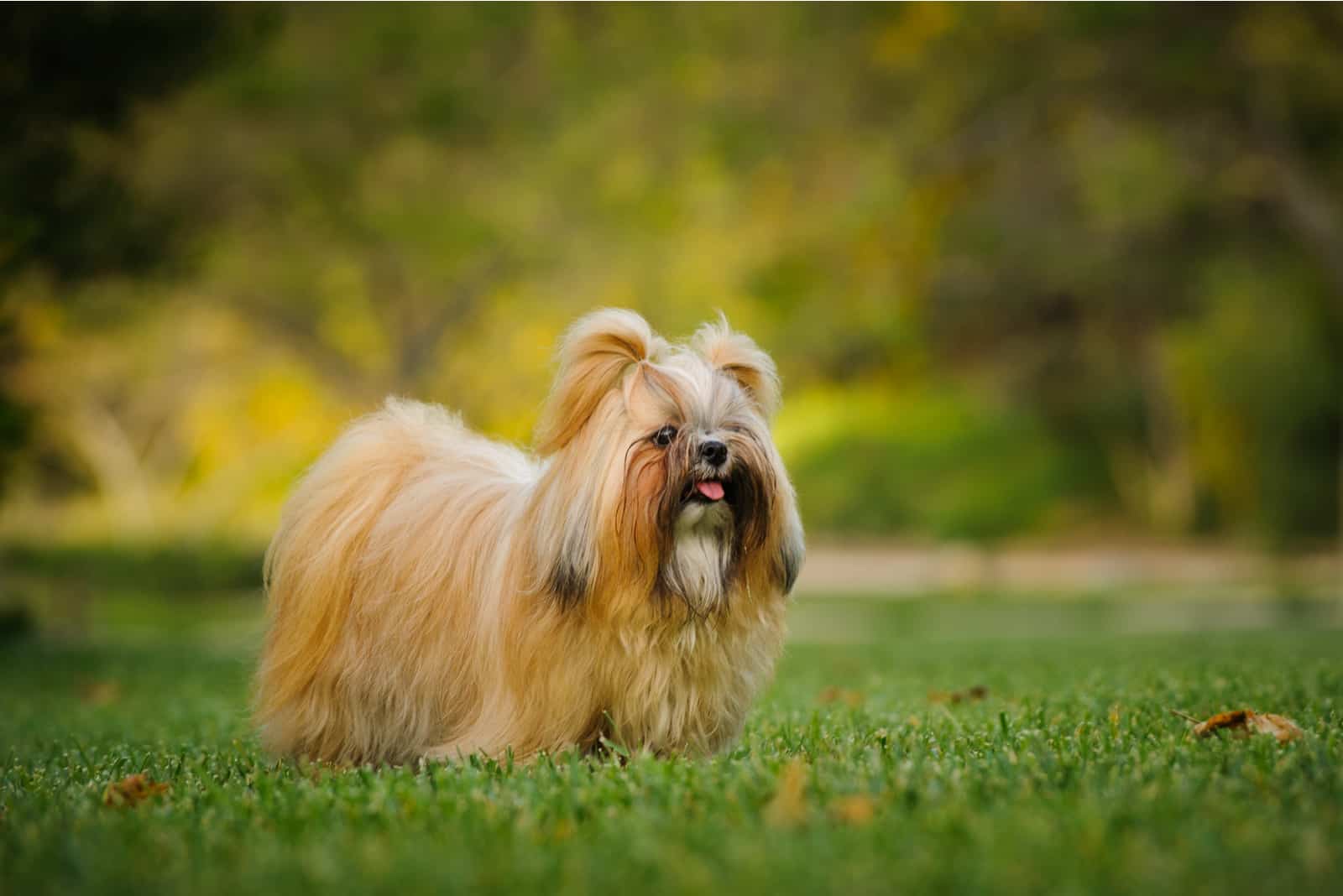
Are Red Shih Tzus Hypoallergenic?
Many people want to get red Shih Tzus not just for their beauty, but for their non-shedding, hypoallergenic coats.
Still, it’s important to note that it isn’t dog’s hair that’s causing you breathing problems, but rather its dander, or dead skin cells.
Dog’s dander, just like his urine and saliva, contains a specific protein that might cause an allergic reaction in individuals.
The dander will get stuck on the dog’s hair and then fly everywhere during the shedding season. This is why you might feel as if it’s the dog’s hair that’s causing problems, and not what’s stuck on it.
As all dogs produce dander, urinate and drool, it’s impossible to say that any dog breed is 100% hypoallergenic. If you struggle with very severe dog allergies, chances are even non-shedding breeds will bother you.
Still, red Shih Tzus are as close to being hypoallergenic as can be. They don’t shed, and even if they were their small size means they don’t have as many hairs as larger dogs. Also, they don’t drool, and they are very clean.
Most allergy sufferers haven’t reported having any issues from being around Shih Tzus.
Of course, exceptions exist. As such, if you’re an allergy sufferer, I’d advise you to spend some time around Shih Tzus before deciding to buy one. This can help you determine whether this is the right dog breed for you.
Some other hypoallergenic dog breeds you might also consider include Maltese, Bichons, Lhasa Apsos, and Poodles.
Are Red Shih Tzus Easy To Train?
Shih Tzus are highly intelligent dogs. This alone means they can learn new tricks quickly.
Not just that, but they are obedient and calm and they love their owners with all their hearts. They love nothing more than to make their human family members proud, and they’ll love to complete any task you give to them.
While they might have a stubborn streak, this rarely gets the best of them, making them a highly trainable breed.
However, they can be very challenging to potty train. The main reason behind this is that they have a small bladder, so they cannot hold it in for a long time. When a Shih Tzu has to go, he has to go fast.
Not just that, but these pups are prone to anxiety, and this can make them wet themselves.
As such, it’s important to arm yourself with patience if you want to properly potty train your Shih Tzu as quickly as possible.
Can A Shih Tzu Have Red Eyes?
The standard eye color for Shih Tzus is dark brown, with the exception of blue Shih Tzus that might have blue eyes.
The only exceptions are albino Shih Tzus. Due to their lack of pigment, their eyes will appear to be red in color, which is a unique feature many people love them for.
A Shih Tzu in any color other than albino shouldn’t have red eyes.
Even red Shih Tzus will have dark brown eyes, and not red. If anything, their eyes might be mistaken for black for how dark they are.
Red eye in Shih Tzus is usually a sign of eye infection or irritation. It can occur either from a generalized condition or from a blood vessel that has infiltrated the irritated part of the eye.
Most of the time, the dog’s whites will be red, and not his irises. This is another feature that is making them different from albino dogs’ eyes.
As such, if you notice your Shih Tzu’s eyes have turned red, it’s essential to take him to the vet. Eye irritations can be very painful for the dog, and they might cause permanent eye damage if you don’t treat them on time.
Are Red Shih Tzus Brachycephalic?
Yes, Shih Tzus are brachycephalic dogs, even though their flat muzzle is somewhat hidden with their long coat.
Brachycephalic dogs have a very short snout. In fact, many Shih Tzus might even appear to be entirely flat-faced! This gives them a cute appearance everyone seems to love.
Unfortunately, brachycephalic dogs are prone to various health conditions due to the shape of their snout. Most importantly, they are prone to brachycephalic airway syndrome.
Brachycephalic airway syndrome can lead to four different abnormalities. For a red Shih Tzu to be considered to suffer from this syndrome, he needs to experience the symptoms of at least one of these abnormalities:
• Elongated soft palate. This health problem occurs when the soft tissue located on the top of the mouth is elongated, extending all the way to the back of the throat. This can block the windpipe, also known as the trachea.
• Hypoplastic trachea. This is when the dog’ s trachea is more narrow than usual, causing breathing issues.
• Stenotic nares. This is the scientific term used to describe narrow nostrils. It affects the dog’s breathing, causing snoring and breathing noises Shih Tzus and other brachycephalic dogs produce. It can be so severe that the dog loses the ability to breathe on his nose.
• Everted laryngeal saccules. This health condition results in the small sacs in the dog’s larynx, known as laryngeal saccules, to turn outwards. They are usually the consequence of stenotic nares or elongated soft palate.
Due to their flat nose, red Shih Tzus are also prone to tracheal collapse or reversal sneezing. They might even collapse when they’re too excited as they often don’t have enough oxygen.
The shape of their head also leads to many eye and hearing problems.
What Is The Rarest Shih Tzu Color?
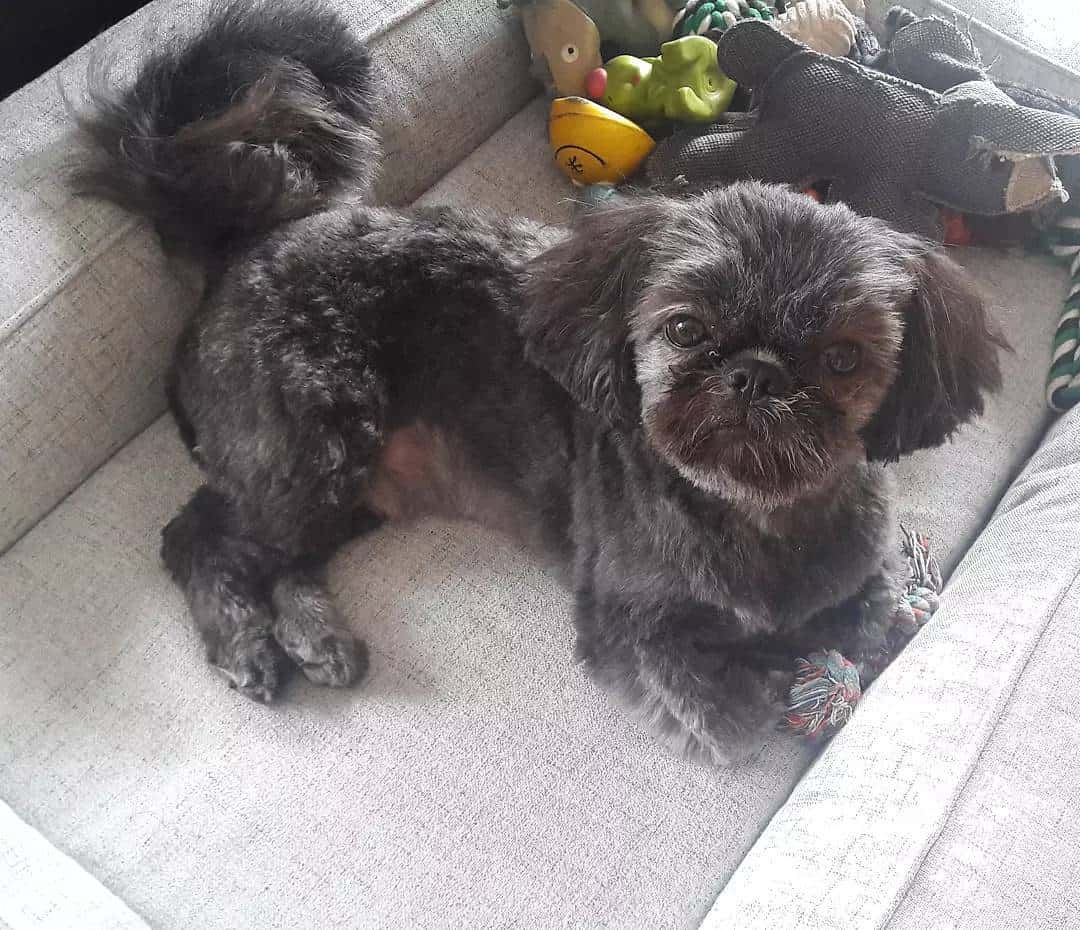
Photo from: @nici_r92
While red Shih Tzus are beautiful, this is far from being the rarest coat color in Shih Tzus.
Believe it or not, the rarest Shih Tzu color is pure black. Yes, solid black Shih Tzus are almost impossible to find.
Black is one of the most dominant colors in all dog breeds, not just Shih Tzus. However, for a Shih Tzu to be considered truly black, he mustn’t have any white markings. This is almost impossible to happen, as most dogs are shown to have at least some discoloration on them.
To get a black Shih Tzu, a breeder must find two solid black dogs and breed them. Even this might result in a litter of puppies with white or gold markings!
Because of this, the price of black Shih Tzu dogs is known to be extremely high.
Pure white Shih Tzu is also very rare, especially when their coat color isn’t coming from albinism. Not just that, but white Shih Tzus with black markings are almost as rare as black dogs. In fact, they are so rare some people argue whether they even exist.
Read Next: 7 Shih Tzu Breeders In Michigan You Cannot Say No To
